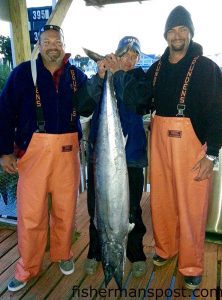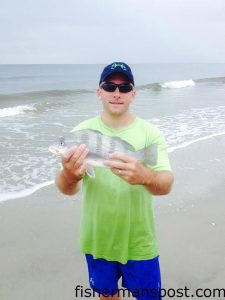Ocean Isle – Winter 2014-2015
Brant, of Ocean Isle Fishing Center, reports that there have been sightings of giant bluefin tuna around spots off Frying Pan Shoals and Brunswick County from the Knuckle Buoy to the Shark Hole. Rumors are flying about the fish, but a local landing of one of the giants has yet to be confirmed. The water temperatures are right and there’s been plenty of bait in the area, so it could quite possibly be the year the tunas return to the Cape Fear region. Anglers looking to connect with one of the giants should troll horse ballyhoo with large skirted lures around areas of bait they mark on the sounder, diving birds, whale and porpoise activity, or other signs of life, and be prepared to do battle with a fish that may exceed 500 lbs.
King mackerel have moved offshore, but anglers can target them for much of the winter in the vicinity of Frying Pan Tower. Finding water temperatures in the upper-60’s and suspended bait is key to finding the kings. Anglers can fool the wintertime mackerel while trolling dead cigar minnows or live cigar minnows and other baits they can jig up ‘on scene’ with sabiki rigs.
Closer to the beachfront, black sea bass will provide plenty of rod-bending fun and tasty meals over the winter months. Anglers can find the bass feeding around bottom structure from a few miles off the beachfront to well offshore around the Shark Hole and Horseshoe. The bass will pounce on cut baits or squid pinned to bottom rigs or metal jigging lures like Stingsilvers.

Bryan Freeman, Tim Gallimore, and Daniel Simmons with a 68.2 lb. wahoo that attacked a ballyhoo near the Steeples while they were fishing out of Ocean Isle Beach on the “Reel McCoy.”
Kyle, of Speckulator Inshore Fishing Charters, reports that anglers have seen some stellar speckled trout action in recent weeks, and many of the fish still haven’t moved into their wintertime spots so it should hold up for some time to come. Solid numbers of fish are still feeding at typical ICW spots from Little River to Holden Beach, and anglers are hooking big numbers on live shrimp fished beneath slip floats. Soft plastic shrimp and grubs are also fooling some of the fish.
More specks (including some 6-8 lbs.) are looking for meals around the Little River jetties, where live shrimp are also producing big results.
Anglers are also hooking up with the trout in the Shallotte and Lockwood Folly rivers, where they’ve been feeding in shallower water around oyster points and grass banks. The river fish have been more receptive to artificials, and anglers are hooking solid numbers on a variety of soft and hard plastic lures.
As the water continues to cool, the ICW trout will begin making their way to the jetties and ocean or well up the creeks and rivers where they’ll spend the winter. Slow presentations of lightly-weighted baits in the creeks are the way to go once the water gets truly cold.
Red drum are feeding around ICW docks and are mixed in with the specks at the jetties, and live shrimp are fooling them in both locations. Mud minnows and soft baits like Gulps will tempt bites from the reds as well.
Black drum are also holed up around docks and other structure in the ICW and Tubbs Inlet. They’ll also pounce on a live shrimp, and cut shrimp on bottom rigs are quite effective as well.

